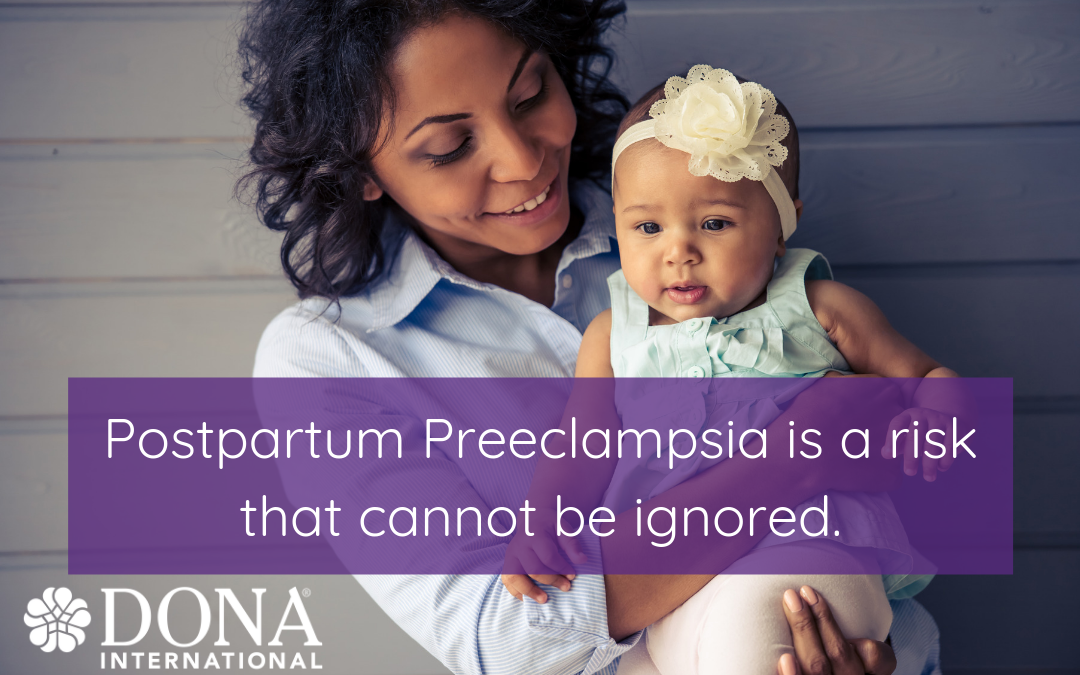By Eleni Tsigas, Chief Executive Officer, Preeclampsia Foundation
May is Preeclampsia Awareness Month. Preeclampsia is one of the three largest causes of maternal mortality in the USA and around the world. Postpartum doulas are in a unique position to encourage parents to watch for symptoms because postpartum doulas are offering their services in those vulnerable first weeks and months after birth when the risk from postpartum preeclampsia is still high. It is important to be aware that this deadly disease can harm people after birth as well as during pregnancy. Today, Eleni Tsigas, the Chief Executive Officer of the Preeclampsia Foundation speaks out about important information on postpartum preeclampsia for all doulas and families to know. – Sharon Muza, Blog Manager
Preeclampsia Awareness Month
For Preeclampsia Awareness Month, we are trying to debunk the very common myth that delivery is the “cure” for preeclampsia. The word “cure” leaves mothers thinking they are in the clear and no longer need to focus on their health after delivery. Unfortunately, 75% of maternal deaths related to preeclampsia happen in the postpartum period, up to six weeks after delivery, so healthcare providers and moms alike need to remain vigilant, even after delivery.
“If I die, take care of my baby.” Katie Costello texted these words to her sister when her health took a downward spiral after delivering her baby boy. She developed severe postpartum preeclampsia and was close to death but thankfully recovered several months later. “This trial in my life has given me true purpose,” said Katie. “It is my duty as a survivor to help women who are going through this know they are not alone, and to educate other women to never let someone else speak on behalf of their body. A new mother’s health and wellness is just as important as their precious new bundle of joy. We need to work together to put an end to maternal and infant deaths due to this deadly disease. If my story of struggle can help other moms realize that it will be okay with the support and love of her family, friends, and fellow survivors like myself, then I have done my job.” You can read Katie’s full story here.
Most women with preeclampsia will deliver healthy babies and fully recover. However, some women will experience complications, several of which may be life-threatening. A woman’s condition can progress to severe preeclampsia, eclampsia, or HELLP syndrome quickly. Delivery, sometimes after a period of expectant management (“watchful waiting”), is a necessary intervention. Once delivered, a mother still needs to receive care if she is experiencing high blood pressure and related preeclampsia symptoms.
 Any woman can develop preeclampsia after her baby is born, whether she experienced high blood pressure during her pregnancy or not. It’s important that mothers who recently delivered continue to monitor their health after delivery. They should measure their blood pressure for at least six weeks postpartum, especially during the first week, which is the most critical.
Any woman can develop preeclampsia after her baby is born, whether she experienced high blood pressure during her pregnancy or not. It’s important that mothers who recently delivered continue to monitor their health after delivery. They should measure their blood pressure for at least six weeks postpartum, especially during the first week, which is the most critical.
Here are some Frequently Asked Questions about postpartum preeclampsia.
What is postpartum preeclampsia?
Postpartum preeclampsia is a serious condition related to high blood pressure. It can happen to any mother who just had a baby. It has most of the same features of preeclampsia or other hypertensive disorders of pregnancy, without affecting the baby.
Risks to postpartum mother:
- Seizures
- Stroke
- Organ damage
- Death
Warning signs:
- Stomach pain (upper right quadrant)
- Feeling nauseous or throwing up
- Swelling in hands and face
- Severe headache
- Seeing spots (or other vision changes)
- Shortness of breath or difficulty breathing
What can patients do?
- Ask if a one-week follow-up appointment is necessary
- Keep all follow-up appointments
- Monitor their blood pressure
- Watch for warning signs and report any to their healthcare provider
- Trust their instincts
For additional information about postpartum preeclampsia, please visit the Preeclampsia Foundation.
About Eleni Z. Tsigas
 Eleni Z. Tsigas is the Executive Director of the Preeclampsia Foundation. Prior to this position, she served in a variety of volunteer capacities for the organization, including six years on the Board of Directors, two as its chairman. Working with dedicated volunteers, board members, and professional staff, Eleni has helped lead the Foundation to its current position as a sustainable, mission-driven, results-oriented organization.
Eleni Z. Tsigas is the Executive Director of the Preeclampsia Foundation. Prior to this position, she served in a variety of volunteer capacities for the organization, including six years on the Board of Directors, two as its chairman. Working with dedicated volunteers, board members, and professional staff, Eleni has helped lead the Foundation to its current position as a sustainable, mission-driven, results-oriented organization.


